LOCAL HISTORY: 'Roundhouse Baby' born in 1875 Hawley
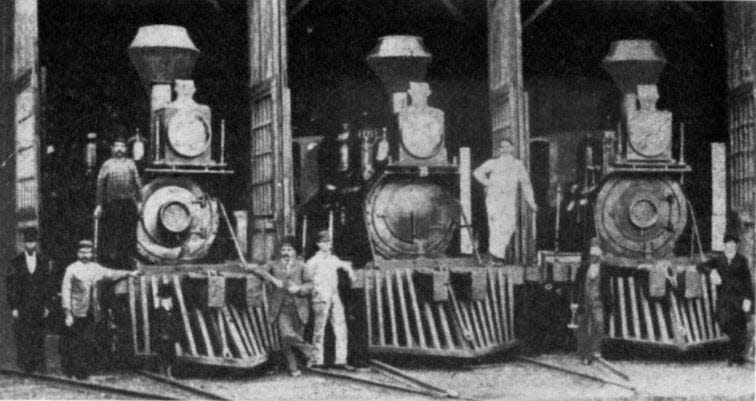
HAWLEY - "Baby! A Modern Joseph" is the screaming headline that was sure to catch attention of readers of The Hawley Times, October 1, 1875. "Baby" was in large, bold type across one column, in a day and age when publishers rarely used headline typeface distinguishable from the article's text.
The story was meant to touch hearts in a way that has not changed through the ages, the very essence of life when a precious, new baby has come into the world.
Babies, mind you, were common then as well, but not when they were born in Hawley's railroad round house.
The roundhouse is where locomotives are parked and serviced, and are turned around on a huge turnstile. The building has to be huge, and is full of things mechanical and oily- not your typical maternity ward.
This story was particularly touching, which as Editor Frank Woodward points out, the family is somewhat reminiscent of that Holy couple and child in Scripture, who as we are told every Christmas, "There was no room for them in the inn."
BABY!
So let us turn the calendar pages back 139 years in the beloved town of Hawley, Pennsylvania. Some of it is familiar, a lot is not. Human need and variableness of compassion is still the same. We will quote freely from the article, interjected with some historical background as needed in brackets.
The headline was "BABY!" with a few subtitles:
"A Modern Joseph
"The Midnight Birth in the Round House
"No One to Love Me, None to Caress"
"The Beauties of a Tramp's Life
"A Pitiful Scene Described by a Times Reporter."
[The Hawley Times was a highly respected journal in its time, chronicling both news of Hawley and surrounding areas, as well as national and world affairs. Frank Woodward and H.P. Woodward founded the newspaper on September 18, 1874. Franks' brother H. P. sold his interest a year later. The newspaper continued, with a small interruption, for nearly 70 years. The 1885 Hawley map locates the Hawley Times office on 14th (River) Street, between 18th (Main Avenue) and 19th (Maple Avenue) on the Middle Creek side.]
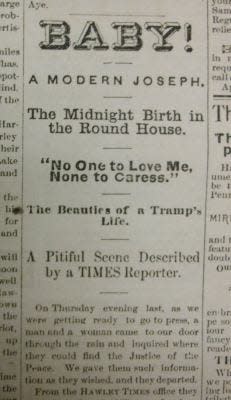
"On Thursday evening last [Sept. 23, 1875], as we were getting ready to go to press, a man and a woman came to our door through the rain and inquired where they could find the Justice of the Peace. We gave them such information as they wished, and they departed.
"From the Hawley Times office they went to the house of Thomas Lawless, one of the poormasters; but as they had no order from the Justice, he informed them he could do nothing for them."
"It was late, and storming quite hard; but the man cheered up his companion, and they sought out R. B. Arnold, Esq. [justice of the peace], who gave them an order on the poormaster, and armed with that they went to Mr. Charles Gilbert, the other poormaster, and the keeper of the Wayne County House, and found food, and lodging for the night."
[The Wayne County House was built in 1860. The landmark on Church Street still stands, last known as the Heritage House, a gift shop, at the corner with Wayne Street.]
"They were on their way to Middletown, where the woman's father lives, and on Friday morning [Sept. 24] they tried to get a pass over the road, but this they failed to obtain, and all-day Friday they sat in many spots around town and wished only such wishes as tramps can wish- probably she that she were dead, and he that he had something to drink."
[They needed a train ticket out of Hawley, which would have taken them to Port Jervis where they could have switched trains to Middletown, NY.]
"On Friday night they found as darkness closed around about them, that they had nowhere to lay their heads, and they wandered around like Noah's dove, or Adam and Eve just after they were driven from Paradise. Some pitying one directed them to the roundhouse; but as it was cold and cheerless there, they were directed to a shop a few rods from there where it was warm and comfortable.
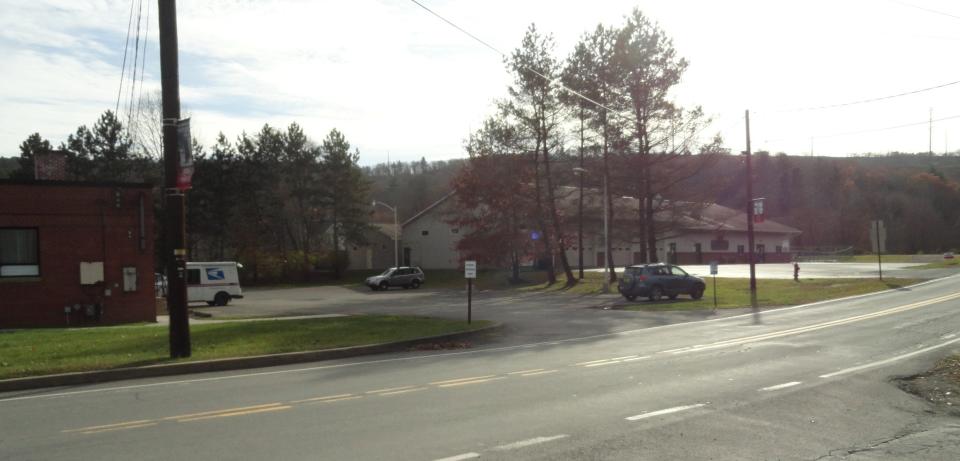
"The man who had this shop under his charge for the night refused to allow them to stay, and the weary woman actually crawled on her hands and knees under two trains of cars back to the roundhouse.
"Now it is against orders to keep tramps in the roundhouse; but the young man in charge resolved that if he lost his job by so doing, he would not turn a suffering woman away, - and so the two wanderers found a place to stay for the second night in Hawley."
Hawley's roundhouse
[The Erie Railroad roundhouse was located along the Middle Creek approximately where the Hawley Fire Station is now located on Columbus Avenue. At that time this was a railroad yard where Pennsylvania Coal Company (PCC) gravity rail cars brought coal into Hawley, and coal was transferred into waiting steam coal trains.
The 1872 Hawley street map shows general shapes of structures. The "roundhouse" is depicted as a round open-air turntable where locomotives could be turned around, and the large maintenance and repair shed facing the turntable, its front curved where the roundhouse garage doors were situated. The back of this shed faced the Middle Creek.
MORE: Winter Wonderland state historical marker dedicated
The only photograph of the Hawley roundhouse this writer has seen shows three locomotives with bell stacks side by side, in their respective bays, facing the turntable.
The tall bay doors, in their open position, appear to be like steel cage doors rather than solid. Taken in about 1880, eight men and one boy are pictured with the locomotives.
Very possibly any number of these men worked there in 1875 when their workplace became a maternity ward.
The roundhouse became necessary once the PCC switched from relying on the canal to transfer coal, to the new Erie rail line in 1863. Locomotives needed to be able to turn around at this point. The roundhouse was no longer needed once the PCC gravity system was shut down in 1885.
![OLD HOTEL - Thomas [McNulty] and his wife, who was about to give birth, spent their first night in Hawley at the Wayne County House in 1875. The hotel on Church Street (known as 16th Street) is still standing.](https://s.yimg.com/ny/api/res/1.2/bg440dxdgGg8wvFyRgtkmQ--/YXBwaWQ9aGlnaGxhbmRlcjt3PTk2MDtoPTUwMQ--/https://media.zenfs.com/en/tri-county-independent/9f1f1d5b85c0f5bf02694ae0e74dc575)
Also referred to as turntables, there were railroad roundhouses in Carbondale, Honesdale and Port Jervis as well. Visitors to Steamtown National Historic Site in Scranton may inspect the preserved, working Delaware Lackawanna & Western Railroad turntable and shed.]
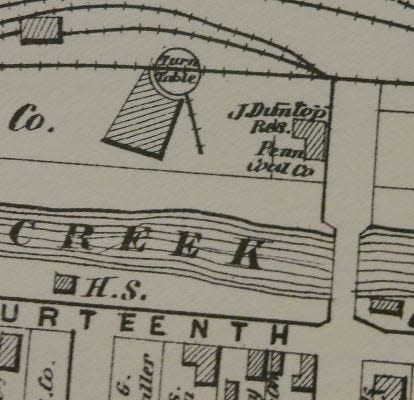
At about midnight
"About midnight the woman was taken violently ill. Dr. Dingman was called, and in a short time a little girl baby was born unto the world in the roundhouse- born amid the escaping of steam and the glare of engine lamps, born perhaps to misery and the ignominy of a tramp's life, yet she may come under the rule of the old song 'And if it be a girl, she shall wear a diamond ring.'
"The poor woman was made comfortable as circumstances would allow- thanks to the kindness of Mrs. S. Jones."
"The next morning in company with the Doctor, we called upon the patient. We found the man very attentive to his wife and she --. The long tramps and hardships had worn her out, and there was no disguising the fact that she was suffering. A draft of cold air was circulating over the floor and when she coughed which was very often- it seemed as through her whole frame would be racked to pieces. The doctor had the draft checked as much as possible, and spoke encouragingly to the sufferer.
"We asked the man some questions, and found out his name is Thomas [McNulty*], and that he is a shoe maker by trade. The last place he had work was at Danville. From there he came to Scranton, and getting no work there, he tramped it all the way to Hawley.
"Dr. Dingman remarked to him that he reminded him of Joseph. 'Don't know much about Joseph,' said Thomas, promptly. 'Do you like whiskey?" enquired Dingman. 'There is no doubt about the liking,' said the man; 'but it's little I can get.'
"The woman and her child have been removed to the house of a man by the name of Hinks, and there she will remain until she gets able to be removed to Middletown.
"The tale is told, - draw your own conclusions, and point your own moral."
Who were they?
Dr. Dingman was a long time Hawley physician. Dr. Abram Coolbaugh Dingman practiced medicine in Hawley from 1867 to 1886, the year he died. His office was on 18th Street (Main Avenue) near where J. Vance Hunt & Son print shop was located at 217 Main Avenue until a few years ago.
Mrs. S. Jones, whose kindness helped the mother be more comfortable, may have been the wife of Salmon Jones who in 1875 had a hotel on 18th Street (Main Avenue). No more has been located about her, but the 1870 Census lists a Salmon Jones, 34, and his wife Rosille, 34, living in South Sterling. They had a one-year-old child Salmon; Mr. Jones was listed as a "car runner."
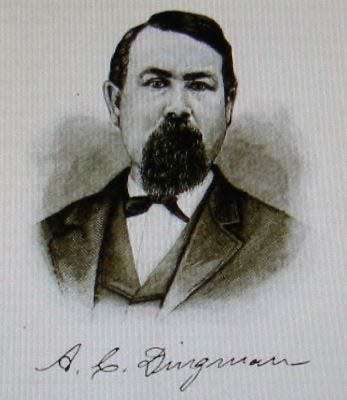
No information has been found about Mr. Hinks, who put the family up after they left the roundhouse, or where Thomas Lawless resided.
There was one follow up found in the pages of the Hawley Times. A week later, in the October 8, 1875 edition, we read,
Seen in Port Jervis
"The woman who had the child in the Hawley roundhouse a few weeks ago, passed through Port Jervis last week, with her husband, on their way to Middletown. The citizens found out their circumstances, and raised them a nice purse of money. We hope the woman won't be stimulated by the reward to go somewhere else and cut up the same trick."
Editor Woodward, as was common in his day, was not shy to editorialize in his news briefs.
What more can we learn about Thomas ["McNulty"], his wife and baby girl? So far, nothing for certain. There are only a few clues offered.
The Tri-States Union of Port Jervis, NY, date uncertain but in 1876- carried a short story headlined, "A Sickening Sight." It referred to a recent report in the newspaper, The Honesdale Chronicle." The original paper reported on [McNulty's] appearance in Honesdale.
"A wretched man and woman- the latter carrying a very dirty child in her arms- both drunk, tramped about begging," the Tri-States Union reported. "They would accept nothing but money, as that can easily be exchanged for whiskey. The trio were father, mother and child.
LOCAL HISTORY: A short history of the D&H Gravity Railroad
"A year ago, the man and woman were in Honesdale, drunk and filthy, and went from there to Hawley. There they put up in the Erie roundhouse where the woman gave birth to a child, which unfortunate one was the one carried by the woman yesterday.
"The family is from Danville, from which place they have tramped thus far. [McNulty] is a shoemaker, but whiskey has brought both him and his wife to their present level. The latter is a good family in Goshen."
Their fate not known
If he was at least 20, he would have been born in 1855 or earlier. A search of census records does show in 1920, a man by the same name, age 83, living in Shamokin, Pa.
This is not far from Danville, where our subject is known to have worked. This man would have been born in about 1837. his wife (in 1920) was M--, age 64. She would have been 19 in 1875, and Thomas, 38. He was listed in the census as a school teacher. They had no child listed at home. The baby would have been about 45.
This of course may be a coincidence. There was also a Julia (same last name the subject of this story) in the 1920 Census, living in Montgomery, Orange County (which also includes Middletown), NY. Julia was listed as a widow.
Hawley's railroad workers
There were many Irish-born residents living in Hawley at the time the Roundhouse Baby was born, some with the same last name. None have been identified here having the same family name as the subjects of this story.
Just up the hill from the roundhouse was the neighborhood of Marble Hill, called Shanty Hill before the 1890's. Columbus Avenue and several side streets make up the neighborhood. It was settled in the 1840's for Irish immigrants who came to work on the Pennsylvania Coal Company gravity railroad operations or the Delaware & Hudson Canal.
The PCC opened its gravity railroad connecting the mines in the Pittston area with Hawley in 1850, for the purpose of creating a second route to transport coal to the canal which went through Hawley.
In 1863 the Erie railroad was connected with Hawley to transport the arriving coal, and the roundhouse was needed. The PCC closed its gravity railroad in 1885. Many of the Irish worked for the Erie railroad in the Hawley area.
We don't have a full list of Erie railroad employees who worked in the Hawley roundhouse.
LOCAL HISTORY : When trolleys rolled down Carbondale's streets
One of them was John Struble Decker (1839-1927), who worked as a machinist. He and his wife Martha had a son, Victor A. Decker; the picture of the roundhouse shows Victor at about age eight or nine, and his father among other men posed with the locomotives. Victor (1872-1950) became an attorney. John Decker, who would have been about age 36 in 1875, would very likely have been employed there at the time of baby's arrival.
Thomas F. Howley (c. 1855-1933) was born in Hawley, and had a career with the Erie Railroad. His first experience in railroad work was with the Pennsylvania Coal Company Gravity Railroad at Hawley. Finding that work monotonous with little chance for advancement, he became an assistant machinist in the Erie roundhouse at Hawley, for a short time.
He later went on to work as a locomotive engineer and other duties.
Three references to the year when Howely was born give it as 1855, 1859 and 1860. Howely would have been anywhere from 15 to 20 when the homeless couple sought shelter at the roundhouse. Could he have been the “young man” who was working there and gave them lodging?
It had to be the talk of the town when the Roundhouse Baby was born into the world, somewhere beside the locomotives.
Reflections
With this small glimpse into the social structures of 1875 in Hawley, PA, we learn the sad tale of one couple who found instances of compassion here, who yet had to make their manger in a roundhouse of steam engines. We can only hope that they eventually were able to overcome issues that were detrimental to them, and went on to lead healthy, stable and productive lives.
There was a community of caring people in that day so long ago, as there are in these modern times, which has so many agencies and groups standing ready for anyone to reach out for help.
A newspaper stories circulated in September 1902 talked about a baby that was born that month in the shops of the Union Pacific Railroad company at Cheyenne, Kansas.
The story, which ran in the Topeka Daily Herald and other Midwest newspapers started out, "Probably the first baby even born in a railroad roundhouse..." In this case, the father was a non-union machinist who was employed there. Non-union workers were being quartered in the roundhouse to prevent them from being in contact with the union pickets, who wanted to get the men to quit working for the company.
They apparently had not heard about the Roundhouse Baby in Hawley, Pa.!
*- NOTE: Because of the description attributed to the man and his wife who are the subjects of this story, their last name has been changed here. This is out of respect for the dignity of and respect for this man and his family, though long gone, and the possibility they have living descendants.
...
Main Sources
Wallenpaupack Historical Society archives
Fultonhistory.com & Newspapers.com (sources of vintage newspapers)
Ancestry.com/via Hawley Public Library
This article originally appeared on Tri-County Independent: The 'Roundhouse Baby' was born in Hawley in 1875.

